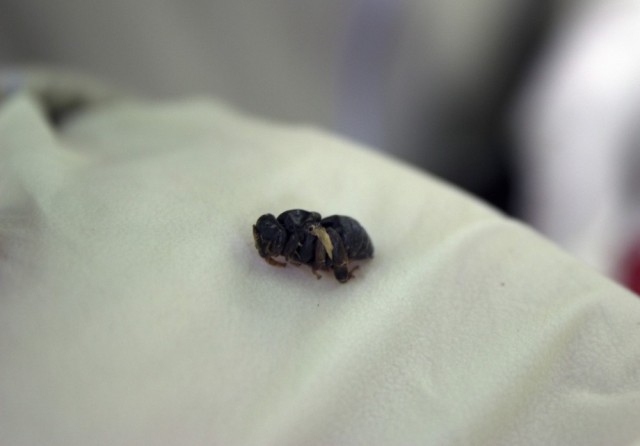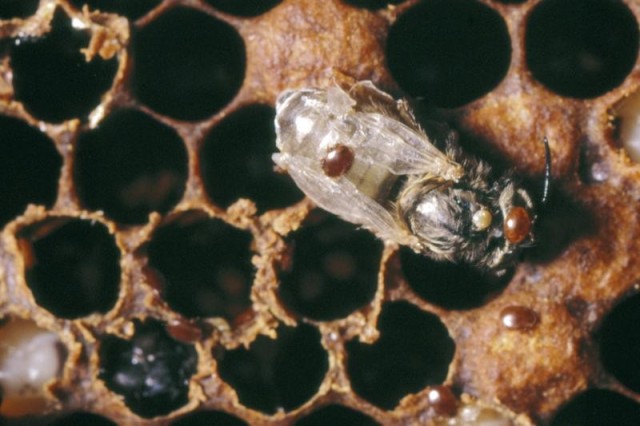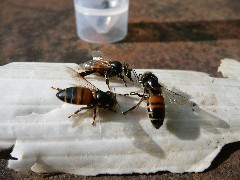A 7th revision post for the British Beekeeping Association’s Module 3 Honey bee Pests, Diseases and Poisoning exam, which I’m taking in March. I’m doing the BBKA’s correspondence course, so I have a tutor setting me papers which she then marks. The last question for paper 2 is a very practical one – trying to work out what has caused a colony to die out.
B5. a colony was fed three gallons of syrup in late October during a period of rather damp weather; next Spring it was slow to build up compared with other colonies in the apiary; there were brown stains on the frames and combs; it recovered enough to produce swarm cells in early July but several of the queen cells had dark coloured walls and the occupants died in the propupal and pupal stages; on sunny days several workers could be found crawling outside the hive or clustered together on grass stalks with what appeared to be bloated abdomens; their wings looked somewhat dislocated and they were unable to fly.
a) give reasons to suggest what diseases might be present in this colony
- Nosema
The information that the colony was fed three gallons of syrup during damp October weather and had brown stains on the frames and combs suggests the bees were suffering from dysentery.
Dysentery is not a disease but a symptom of problems in the bees’ excretory systems. It happens when excess water accumulates in the rectum, causing runny poop and increased brown splats around the hive’s entrance as the bees struggle to hold in. It is not a sign of nosema, but can help spread nosema spores if nosema is present.

Defecation on a hive by bees with severe dysentery. From extension.org.
The suspicion that nosema is likely to be affecting the hive comes from the phrase ‘next Spring it was slow to build up’. This is the only observable symptom of nosema. The reason it stalls the progress of colonies is that the germinating nosema spores inside the gut of an infected bee impair the digestion of pollen, shortening the lifespan of the bee. Infection is particularly devastating in younger bees, which will not be able to digest enough pollen to develop their hypopharyngeal glands properly and be able to produce brood food.
- Black queen cell virus
We may have had a brush with this in one of our colonies this year. Back in June, in my post ‘Long live Queen Neroli, our Jubilee Queen’ I recounted how we were worried at finding a queen cell still capped when the queen should have already emerged:
“We asked John Chapple’s advice. He instructed us to shake the bees off the frame and then gently cut the tip of the queen cell off with a hive tool to see what was inside. The queen revealed was obviously a goner, and had been for some time. “I’m no expert” (hah!) John said, “but that looks like black queen cell virus”. Having looked it up at home, this is a virus associated with the spore disease nosema, which is worrying. You can see her tattered wings and black body below.”

This queen, found in a queen cell from one of our hives in 2012, possibly died from Black queen virus. Copyright Emma Tennant.
Black queen cell virus, which turns queen cell walls dark brown-black and the dead prepupa or pupa inside a yellow colour with a tough skin, is associated with nosema, which may be why the queen cells in the hive we’re investigating have succumbed. The virus can only multiply when nosema is present, and in this case several cells have dark coloured walls. The virus probably enters the developing queen through her gut, so as nosema weakens the gut wall this will allow the virus easier entry than the walls of a healthy gut would.
Our dead queen photographed above is black rather than yellow, so John may have been mistaken about the cause of death being Black queen cell virus.
Normally most honey bee viruses exist in a temporarily inactive state and do not cause signs of disease. However, the presence of other parasites or diseases can activate them. Viruses generally are often transmitted through diseases such as acarine, nosema and varroosis, which act as a vector by in some way facilitating the entry of a virus, or activating previously dormant viruses already present in the host. Varroa is thought to be a particularly common vector and viral replication has been shown to be activated by the presence of varroa. As the mites suck the haemolymph of the bees they also act as tiny hypodermic syringes, injecting the viruses directly into their hosts.

Varroa infestation – © Crown copyright 2010 “Courtesy The Food and Environment Research Agency (Fera), Crown Copyright”
In ‘The Honey Bee Around & About’ by Celia F Davis (2009), she says:
“To a honey bee virus a bee hive must be paradise and when an organism such as Varroa destructor appears on the scene, to act as an efficient vector, it must seem like its Birthday and Christmas rolled into one.” (p39)
- Chronic bee paralysis virus (CBPV)
The beekeeper has noted that “on sunny days several workers could be found crawling outside the hive or clustered together on grass stalks with what appeared to be bloated abdomens; their wings looked somewhat dislocated and they were unable to fly.”
Bloated, distended abdomens (due to a build-up of fluid in the honey stomach) and dislocated wings, causing inability to fly, with crawling on the ground or up plant stems, are symptoms of Chronic bee paralysis virus. There are two main ways the virus can manifest itself in colonies; one causes the problems noted above – abnormal trembling of the body and wings, bees crawling on the ground due to flight inability, bloated abdomens, and dislocated (K letter-shaped, partially spread) wings.
The other form causes hairless, shiny, and black-appearing bees that are attacked and rejected from returning to their colonies by entrance guard bees. The loss of hair is due to their hive mates having nibbled the hairs away. As they are denied entrance to their colony, their flight in front of the hive will be zig-zagging in a similar way to robber bees. These bees will also tremble.
Both forms of symptoms can be seen in bees from the same colony, and may reflect differences among individual bees in inherited susceptibility to the virus (from the Beebase website).

This photo shows three bees with typical CBPV “shiny appearance”. Courtesy The Food and Environment Research Agency (Fera), Crown Copyright.
During July the worker bee population would be at its peak. It seems that close contact amongst overcrowded bees can break hairs from the cuticle, allowing CBPV to spread from diseased bees to healthy bees via their exposed epidermal cytoplasm. It is likely that any factors that result in decreased foraging activities and crowded conditions in the bee colonies may lead to disease outbreaks of CBPV. It is also associated with varroa, and probably acarine.
b) how could the presence of the pathogens be confirmed?
Nosema
Definite confirmation of nosema requires microscopic examination of the abdomens of older adult bees, which can be collected from the hive entrance. Infection is highly variable in a colony, but foragers tend to contain the higher spore loads. Collecting bees leaving to go on cleansing flights rather than returning will be more effective. Send a sample of 30 bees to a microscopist or the UK National Bee Unit service in a small sturdy box (not plastic, which causes rapid sample degradation).
Lab investigation of a sample will also be needed to positively identify bee viruses.
c) how may the beekeeper have been partially responsible for the condition of the colony?
The information given tells us that the colony was fed three gallons of syrup in late October, during a period of rather damp weather. Sugar syrup feeding generally needs to be finished by early October in Britain, as if syrup is fed too late in the year the bees will have insufficient time to evaporate the excess water, and the syrup will be stored and could ferment, causing digestive problems for the bees when they come to feed on it later. Dysentery is caused by excess water accumulation in the rectum, due to diet or if the bees have been unable to fly for several days due to bad weather.
This late feeding of sugar syrup in unsuitable weather by the beekeeper probably caused the bees to develop dysentery and defecate within the hive, spreading nosema spores already present in the hive more quickly. The younger house bees will attempt to clean up the faeces, causing them to come into contact with the nosema spores in the faeces and become infected.
Widespread nosema infection could have weakened the colony, making it slow to build up in the spring and transmitting black queen cell virus to the queens in their blackened cells. This probably also left the colony more vulnerable to varroa and viruses associated with varroa, such as chronic bee paralysis virus. All this exacerbated by an unfortunate feeding choice in the autumn!
d) is there any advantage in uniting this colony to another one; give reasons?
The colony may currently be queenless if it has been unable to produce a healthy queen. If this is the case, uniting it with a queen-right colony will give it a chance of survival. As several workers have been observed unable to fly it is certainly likely to be low in numbers, and may be unable to build up enough stores and new bees to last overwinter without uniting.
There is possibly a genetic susceptibility to Chronic Bee Paralysis Virus, so requeening with a queen from a different strain is often recommended in bad cases. Uniting the afflicted colony to another one would fulfil this.
The disadvantage will be the chance that this colony could infect a healthy one. The beekeeper will have to weigh up whether it is worth the risk.
e) why may it be advantageous to fumigate the combs?
Fumigation would destroy the spores of nosema and several other infectious diseases which might be present on the combs. It is very difficult to treat honey bee viruses, so a good approach is to treat for vectors such as nosema, to try and reduce the exposure of bees to viruses.
Do you agree with this diagnosis? Have you ever come across similar symptoms in your hive?
References:
- Guide to Bees and Honey, Ted Hooper & Margaret Thomas, Northern Bee Books (2010)
- The Honey Bee Around & About, Celia F Davis, Bee Craft Ltd, (2009)
- Keeping Healthy Honey Bees, David Aston & Sally Bucknall, Northern Bee Books (2010), p66
- Mid Atlantic Apiculture Research Consortium (MAAREC), Bee diseases and their control (2005)
- Mid Bucks Beekeepers Association, Module 3 exam notes, p33
- National Bee Unit Beebase website
- Practical Beekeeping, Clive de Bruyn, Crowood Press (1997)
- Scientificbeekeeping.com, Randy Oliver


“Viruses generally are often transmitted through diseases such as acarine, nosema and varroosis, which act as a vector by in some way facilitating the entry of a virus, or activating previously dormant viruses already present in the host. ”
Some years ago I asked (via the Irish Bee List I think) whether the Isle of Wight Disease which was attributed to Acarine, discovered about that time, but later identified by Bailey as Chronic Paralysis Virus could actually have been transmitted by the mite. I had a reply from Norman Carreck that this was not the case as there were colonies with one but not with the other.
LikeLike
I think the weirdly cold weather (-5C and frosts in May) at the time of the first Isle of Wight outbreak, causing large numbers of bees to be trapped inside their hives, probably contributed to the Chronic Paralysis Virus taking hold in so many colonies.
LikeLike
I keep thinking that maybe it’s good I don’t get into bee-keeping.
Not that there’s any immediate chance of it, but you never know.
Happy holidays.
LikeLike
All this talk of diseases may sound very worrying, but remember that most colonies do survive, despite all the creatures out to get them! Sometimes I wonder if it’s the bees keeping me going rather than the other way round. Happy holidays to you too.
LikeLike
This isn’t something I know anything about,beyond the usual disappearing bees, but it’s grotesquely fascinating. I hope that your bees are ok and that you and they had a lovely Christmas.
LikeLike
It’s a very technical post, probably doesn’t make much sense to non-beekeepers! I did have a lovely Christmas thanks, including some new bee book presents – hope you did too x
LikeLike
I was wondering whether to do the correspondence course and this has convinced me it is a good idea. It’s all good learning the books and learning from experience, but the questions really make you draw on theory and apply to practical situations. The correspondence course looks like good practice before the exam.
Currently studying bee communication and dances, it really is very technical and complicated. Shame there aren’t some classes or lectures held on more advanced topics. I might look for some lectures or workshops next year. Great post!
LikeLike
The best thing about it from my point of view is that it forces me to revise! And the examiners can give you tips that come from decades of experience. The dances are complex, I found it tricky remembering all their the different meanings. Amazing that they can have slightly different dialects too, depending on the sub-species of bee.
LikeLike
True, I forgot how tutors are good to structure learning, although blogging helps me to revise. With some topics I see there is overlap with other exams, so I am trying to learn the fundamental principles first then go into advanced principles later. The dancing will require more study! Wish BBKA had a night school!
LikeLike
You were one of the people discouraging me from feeding sugar water in October. Thanks for doing that. I had built a feeder on my Warre, accessible from the outside and wanted to try it out, but after reading your warning comment, I changed my mind and built a frame to hold dry sugar above the brood box. So far, so good. I don’t know if they are eating the sugar, I can see plenty of honey through the observation window but they were flying today on a rare sunny day, and that’s a good sign.
LikeLike
No problem. The feeder will be useful in early autumn and if they need help at other times of the year. Glad you’ve seen them flying 🙂
LikeLike
I get so sad seeing bees with virus and parasites. But seeing your queen so peacefully laid to rest, well no words. I know bees have a short life as it is, but have so many ways to have it end early. 😦
LikeLike
Yes. Really hoping we have better luck with our queens in the coming year.
LikeLike
This is fascinating – reading yours and others comments about a subject I know nothing of really. That said I am very interested in the life of bees and have two other friends who are too. I shall be telling them about your blog:) Habbee 2013!!! – Alison
LikeLike
Thanks 🙂 I love your paintings! Do you ever do paintings of bees?
LikeLike
Hi Emily – thanks fo rthe compliments – I am glad my animals resonate with you. I have to admit I have only ever painted one bee and he was more an impression than a detailed study if you know what I mean. That said I have painted some detailed spiders and ladybirds and perhaps I will apply myself to painting some proper bees…I love the look and shape of bee hives and painted a large apple orchard scene with 3 hives in it – that is hanging in my mum’s house now but I can make prints of it. To paint a watercolour bee or a few bees on say a 5×7 inch sheet would be about £35:) Alison
LikeLike
£35 is very reasonable, I will bear that in mind when birthdays come up, thanks 🙂
LikeLike
Hi Emily – that’s wonderful – meantime I wish you and th e bees very well:) Alison
LikeLike